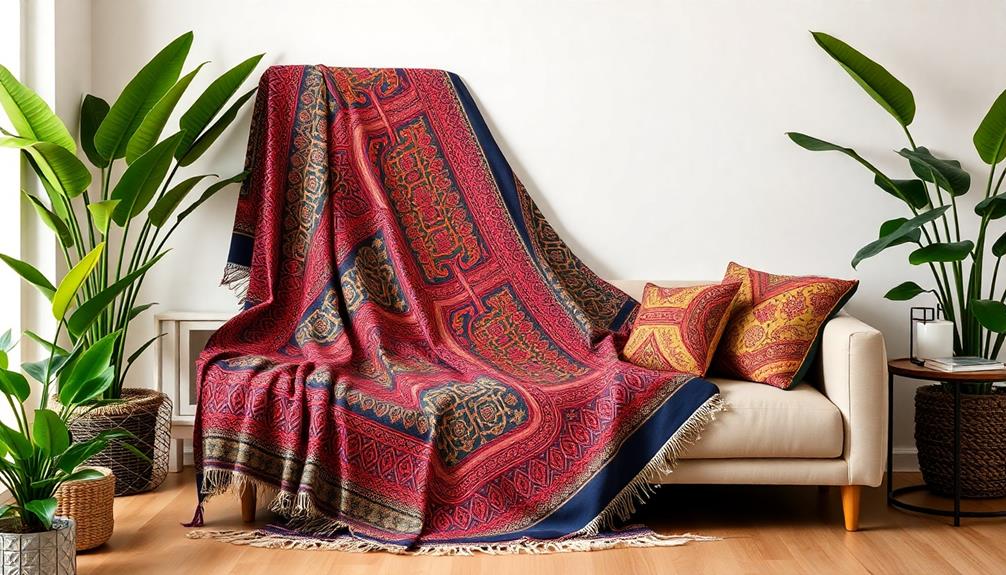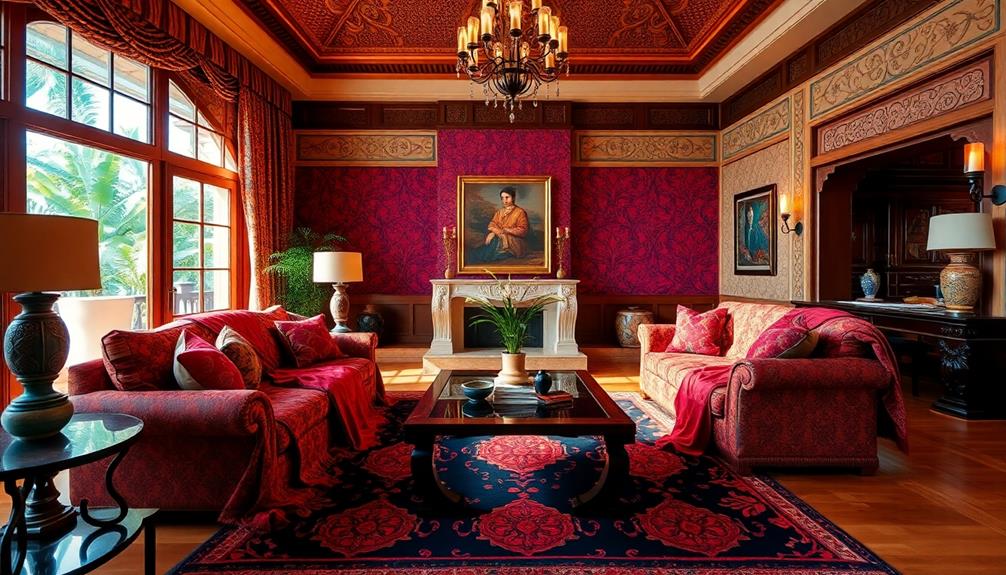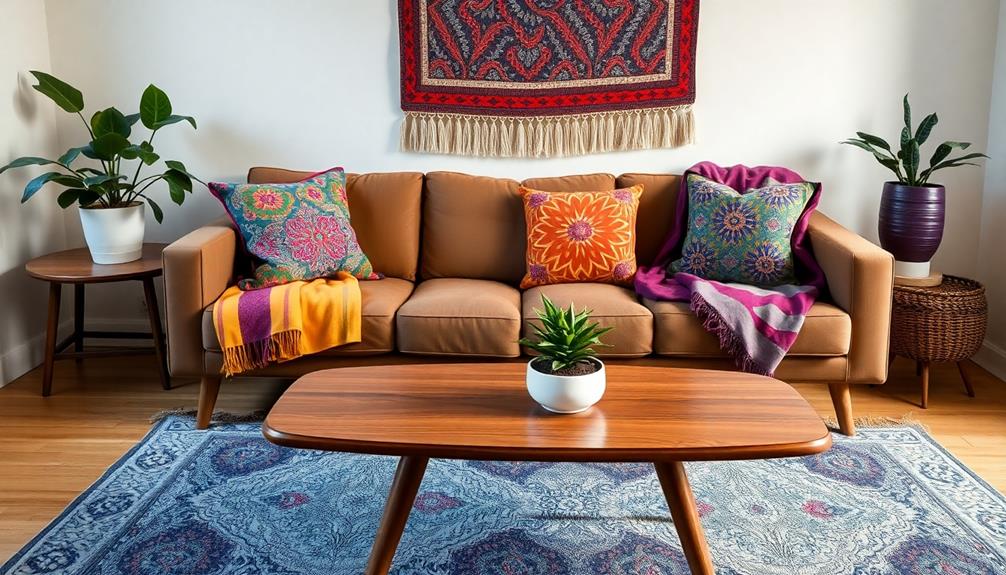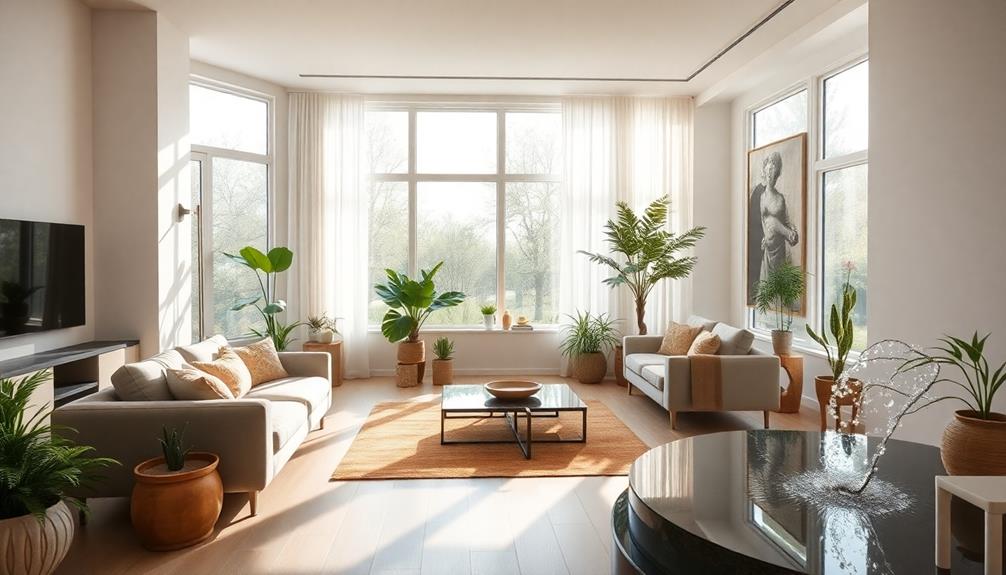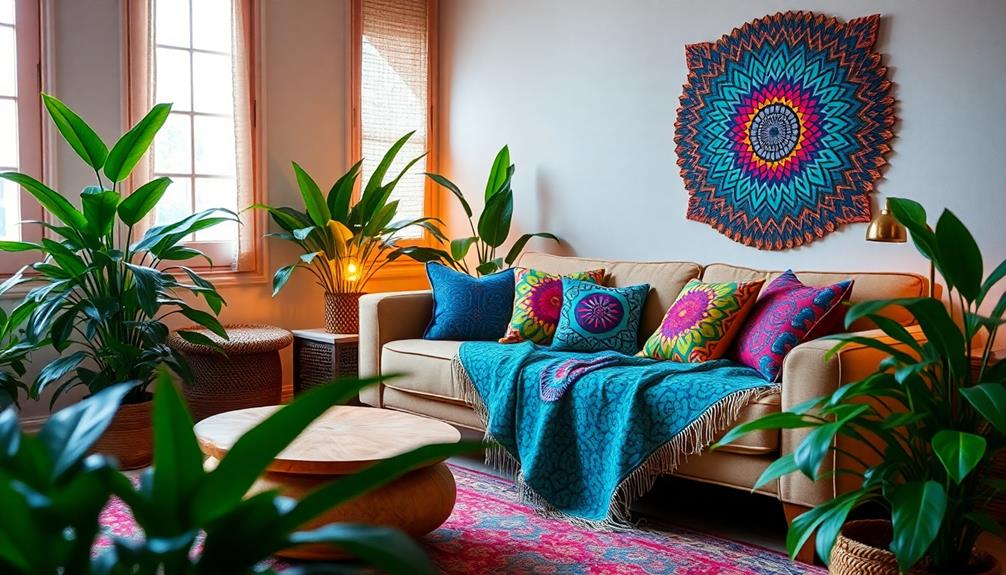Indonesian textiles are a must-have for modern homes because they blend rich cultural heritage with contemporary design. Their vibrant colors and intricate patterns create a stunning visual impact that enhances your decor. Each piece tells a unique story, reflecting the diverse traditions and craftsmanship of Indonesia. By incorporating these textiles, you support artisan communities while adding depth and character to your space. Plus, sustainable practices in their production align with eco-friendly trends. These textiles aren't just beautiful; they carry meaning and history. Explore how these unique fabrics can transform your home into a celebration of art and culture. Elevate your interior design with the timeless elegance of Indonesian textiles. From batik and ikat to traditional weaving techniques, these fabrics bring warmth and personality to any room. Whether you’re looking to accentuate a minimalist aesthetic or infuse a pop of color into your decor, these textiles have the power to transform your living space into a showcase of global style and craftsmanship.
Key Takeaways
- Indonesian textiles introduce vibrant colors and intricate patterns that enhance modern home aesthetics and create a unique focal point in any room.
- Incorporating traditional textiles like batik and ikat adds cultural narratives and stories, enriching the ambiance and character of contemporary living spaces.
- The sustainable production methods of these textiles align with eco-friendly trends, appealing to environmentally conscious consumers and promoting responsible consumption.
- Each piece reflects regional diversity and craftsmanship, allowing homeowners to celebrate and showcase Indonesia's rich heritage and artistry in their decor.
- Using Indonesian textiles supports local artisans and empowers communities, making your decor choices contribute to social and economic sustainability.
Cultural Heritage of Indonesian Textiles

Rooted in centuries of tradition, Indonesian textiles like batik and ikat reflect the vibrant cultural heritage of the archipelago. When you explore these fabrics, you'll discover that each region has its unique weaving techniques and motifs, commonly used to convey significant cultural meanings.
These textiles embody stories and traditions passed down through generations, showcasing the artistic wealth of Indonesia, similar to how Indonesian decor masks represent rich cultural narratives.
Traditional fabrics play a vital role in ceremonies and rituals, emphasizing their importance in the spiritual and social fabric of Indonesian life. For instance, textiles like Ulos and Kain Kapal are recognized as intangible cultural heritage, underscoring their role in preserving cultural narratives and practices.
When you incorporate these textiles into your home, you're not just adding decor; you're honoring a rich cultural legacy.
The integration of natural dyes and sustainable materials in traditional weaving practices highlights a commitment to both cultural heritage and environmental sustainability. This thoughtful approach enhances the emotional impact of these textiles, making them more than just beautiful pieces.
Economic Benefits of Traditional Weaving

Incorporating Indonesian textiles into your home not only honors cultural heritage but also supports the economic importance of local communities. Traditional weaving provides artisans with a consistent income, sustaining livelihoods and enhancing local economies. By purchasing these textiles, you contribute to financial independence, especially for female artisans who play significant roles in their communities.
The textile industry also encourages tourism, drawing visitors keen to experience Indonesia's rich culture, which in turn boosts local businesses and services. Additionally, traditional weaving promotes sustainable practices through the use of natural materials, contributing to environmentally friendly economic growth.
Here's a quick overview of the economic benefits:
| Economic Benefit | Impact |
|---|---|
| Income for Artisans | Supports livelihoods of local weavers |
| Boosts Local Tourism | Increases demand for local businesses |
| Empowers Women | Provides financial independence for women |
| Promotes Sustainability | Utilizes natural materials for weaving |
Unique Regional Styles and Techniques
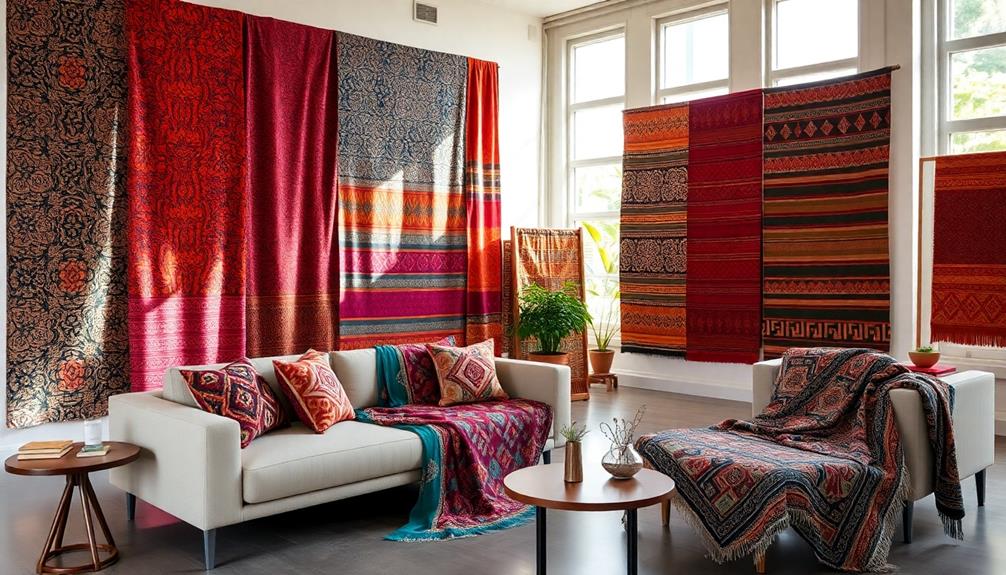
When you explore Indonesian textiles, you'll discover a vibrant tapestry of unique regional styles and techniques that reflect the rich cultural diversity of the archipelago.
For instance, the intricate Tenun Gringsing from Bali incorporates protective beliefs and rituals, often used to create a sense of spiritual connection in your living space. Additionally, these textiles embody the essence of Indonesian artistry, much like the beautiful traditional decor masks that enhance aesthetic appeal in homes.
In Lombok, you'll find Songket, a luxurious fabric featuring colorful cotton threads interwoven with gold or silver accents, perfect for adding elegance to any modern decor.
Another fascinating example is the Tenun Ikat Flores, where motifs signify status and wealth, showcasing the cultural heritage of the Flores community. The ikat weaving method, particularly in Tenun Dayak, serves as a means of storytelling, allowing you to connect with the spiritual narratives of the region.
Finally, the Ulos fabric from the Batak community stands as an intangible cultural heritage, integral to various ceremonies and often used to celebrate important life events.
Each textile not only enhances your living space but also tells a story, making them a must-have for anyone looking to embrace the beauty of Indonesian craftsmanship.
Significance of Motifs and Symbolism
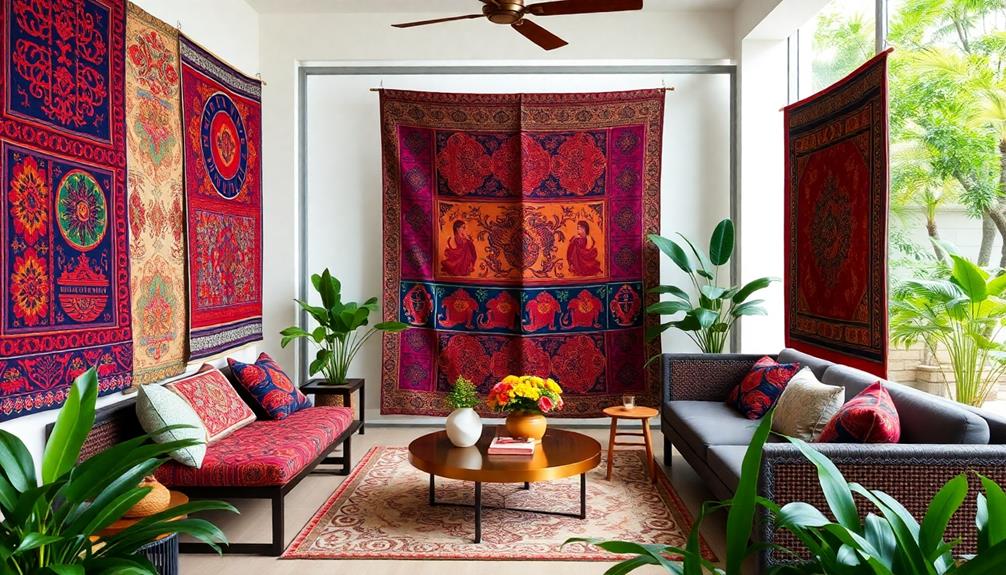
When you explore Indonesian textiles, you'll find that each motif tells a story, reflecting rich cultural narratives.
These textiles, often featuring vibrant colors and intricate patterns, not only enhance living spaces but also provide comfort while reflecting cultural heritage.
The symbolism behind various design elements, from animal figures to geometric shapes, reveals the deep significance tied to regional diversity.
By incorporating these textiles into your home, you not only enhance your decor but also celebrate the heritage and values they represent.
This integration can be seen in how Indonesian decorative pillows add a personalized touch to modern interiors.
Cultural Narratives Through Motifs
Indonesian textiles often weave together intricate motifs that tell powerful cultural stories, deeply rooted in the diverse traditions of the archipelago. These textiles are crafted using traditional techniques that showcase the rich cultural heritage of the region, reflecting the use of natural materials in their creation.
For a long time, these motifs have served as a visual language, allowing artisans to communicate cultural narratives and preserve their heritage. Each region boasts unique designs—like the Atoni Lafayek motif from Timor, which connects ancestors to natural elements such as crocodiles, revealing a bond between culture and nature.
Animal designs symbolize strength and loyalty, while floral patterns often represent beauty and spirituality, reflecting community values. Geometric patterns may indicate social status or lineage, echoing the hierarchical structures within local societies.
Specific motifs, such as those in Sasirangan fabrics, are believed to carry protective qualities, showcasing the intersection of art, culture, and spirituality.
Symbolism in Design Elements
Motifs in Indonesian textiles aren't just decorative; they carry profound symbolism that reflects the identity and values of the communities that create them. Each design serves as a visual narrative, connecting you to the rich cultural heritage of Indonesia. For example, animal symbols often represent strength and loyalty, while floral patterns embody beauty and spirituality.
Take a look at the following table that summarizes some of these significant motifs:
| Motif | Symbolism | Cultural Significance |
|---|---|---|
| Animal Symbols | Strength and Loyalty | Represents the community's values |
| Floral Patterns | Beauty and Spirituality | Embodies the connection to nature |
| Geometric Designs | Social Status and Lineage | Visual language of identity |
| Atoni Lafayek | Ancestors and Crocodiles | Connection between natural elements |
| Regional Variants | Diverse Stories and Values | Highlights the rich tapestry of narratives |
Regional Diversity in Patterns
Exploring the regional diversity in Indonesian textile patterns reveals a fascinating tapestry of cultural identity and values. Each region showcases unique weaving styles and motifs, making these textiles significant for your modern home.
Traditional designs often feature animal, floral, and geometric patterns, each carrying deep meanings. For instance, animal motifs symbolize strength and loyalty, while floral patterns represent beauty and spirituality. These textiles aren't only beautiful but also serve as a representation of the rich cultural heritage that Indonesia embodies.
Take the Atoni Lafayek from Timor textiles, which reflects ancestral connections and illustrates the intertwined nature of cultural beliefs. These textiles serve as rich storytelling mediums that bring your space to life.
Fabrics like Songket and Tenun not only enhance your decor but also signify social status and identity, acting as visual languages that convey the heritage of their communities.
As modern interpretations emerge, you can find contemporary designs that honor traditional craftsmanship while adding depth and character to your home.
Contemporary Applications in Home Decor

Transform your living space by incorporating Indonesian textiles, which seamlessly blend rich cultural heritage with modern aesthetics. Textiles like batik and tenun introduce intricate patterns and vibrant colors that make a striking impact in any room.
These textiles align beautifully with Balinese design concepts, emphasizing natural materials and earth tones that create a harmonious environment traditional craftsmanship. When you add these pieces to your decor, you don't just beautify your space; you also invite stories and traditions from Indonesia into your home.
Consider using songket or tapis as statement pieces in your living room, or opt for smaller accents in your bedroom. These textiles create a warm, inviting atmosphere that feels both cozy and sophisticated.
The tactile qualities of traditional weaving techniques like ikat and gringsing add depth and texture, making it easy to layer and enhance your decor.
Sustainable Practices in Textile Production

When you explore Indonesian textiles, you'll discover a rich tradition of using natural dye techniques that aren't only vibrant but also environmentally friendly.
This commitment to sustainable practices mirrors the emphasis on sustainable urban development practices seen in modern housing trends.
These practices empower local communities, ensuring artisans thrive while preserving their cultural heritage.
Plus, the use of eco-friendly materials like doyo leaf fibers highlights a commitment to sustainability in textile production.
Natural Dye Techniques
Natural dye techniques play an essential role in the world of Indonesian textiles, offering a sustainable solution that respects both the environment and cultural heritage. By utilizing plant-based materials like indigo, turmeric, and various leaves, artisans create vibrant colors without harmful chemicals, ensuring a minimal environmental impact. This commitment to natural dyes not only enhances the aesthetic appeal of the textiles but also emphasizes the cultural significance of each piece.
Additionally, these textiles often complement tropical contemporary house designs, enhancing the overall ambiance of modern living spaces. As you explore these textiles, you'll notice the deep connection they've to the land and its heritage. Artisans engage in sustainable harvesting practices, ensuring that the dye plants are grown and collected in ways that support biodiversity and local ecosystems.
This thoughtful approach helps maintain the delicate balance of nature while preserving traditional techniques passed down through generations. With the growing awareness of sustainable fashion, textiles dyed using natural methods are becoming increasingly valued. They resonate with modern consumers like you who seek eco-friendly and authentic home decor options.
Community Empowerment Efforts
Community empowerment efforts in Indonesian textile production are reshaping the landscape of sustainable fashion. These initiatives focus on utilizing natural dyes and local resources, supporting both artisans and the environment. Organizations like Threads of Life work with over 1,000 weavers across 12 Indonesian islands, fostering sustainable livelihoods while preserving traditional weaving techniques.
This aligns with the principles of traditional Indonesian style home decor, which emphasizes harmony with nature and utilizes natural materials.
By promoting women's roles in weaving, these efforts enhance economic independence and strengthen community ties through shared practices and knowledge. You'll find that these sustainable practices not only provide income for artisans but also encourage eco-friendly methods, reducing environmental impact.
This approach allows local artisans to thrive while maintaining their cultural heritage. Integrating traditional craftsmanship with modern market demands, these community empowerment efforts pave the way for ethical fashion that respects both people and the planet.
When you choose textiles from these initiatives, you're not just decorating your home; you're also supporting a movement that values sustainability, craftsmanship, and community. Embracing these textiles means you're contributing to a brighter future for artisans and their communities, ensuring that the rich cultural heritage of Indonesia continues to flourish.
Eco-Friendly Materials Usage
Indonesian textiles are gaining recognition for their eco-friendly materials and sustainable production practices. Many traditional textiles use natural dyes derived from plants, which not only promotes environmentally friendly practices but also reduces the reliance on synthetic chemicals.
This commitment to sustainability is also reflected in the traditional Indonesian housing designs that emphasize the use of local materials and promote natural resource management, as seen in traditional housing structures. When you choose these textiles, you're supporting artisans who utilize sustainable materials like cotton, silk, and fibers from local plants, ensuring that their weaving practices benefit both the environment and local economies.
Initiatives like Threads of Life highlight the importance of sustainable livelihoods, collaborating with over 1,000 weavers to promote eco-friendly production methods and responsible natural resource usage.
You'll find that traditional weaving techniques often involve community participation, fostering a culture of collaboration that preserves craftsmanship while encouraging sustainable practices through shared knowledge of resource management.
As you embrace these beautiful textiles, you're part of a growing movement toward sustainable and ethical fashion. Consumers like you're increasingly seeking products that aren't only aesthetically pleasing but also environmentally responsible.
Frequently Asked Questions
Why Textiles Are an Important Part of Our Everyday Lives?
Textiles shape your daily experiences by adding comfort and style to your space. They express culture, tell stories, and connect you to traditions while supporting communities. You'll appreciate their beauty and significance in your life.
What Is an Indonesian Style of Textile?
"Don't judge a book by its cover." Indonesian textiles, like batik and ikat, showcase vibrant patterns and rich histories, embodying cultural stories that transform your space into a tapestry of tradition and artistry.
What Is the Importance of Textiles in Culture?
Textiles play an essential role in culture, representing identity, heritage, and community narratives. They connect you to traditions and values, showcasing artistry and craftsmanship, while also supporting local artisans and promoting sustainable practices within society.
How Are Textiles Used in Homes?
Textiles weave warmth into your home, transforming spaces with vibrant colors and intricate patterns. You'll find them draping walls, adorning tables, and cozying up your sofa, blending functionality with an artistic touch that captivates and comforts.
Conclusion
Incorporating Indonesian textiles into your home decor is like weaving a vibrant tapestry of culture and sustainability. These unique pieces not only bring warmth and character to your space but also celebrate the rich heritage and craftsmanship of Indonesia. By choosing these textiles, you're not just decorating; you're telling a story that connects the past with the present. Embrace the beauty and significance of these handmade treasures, and watch your home transform into a sanctuary of style and meaning.

